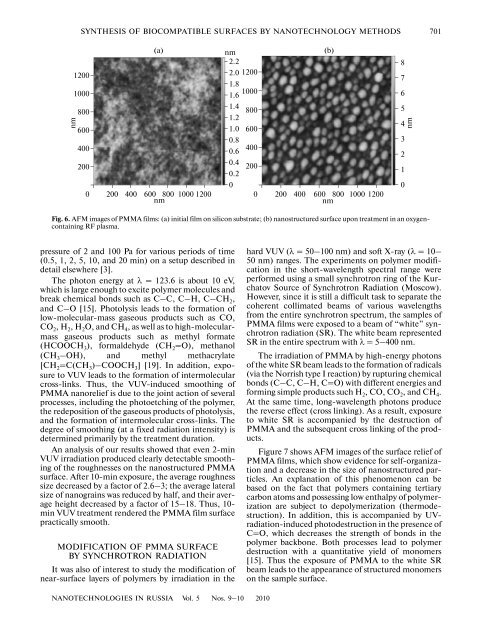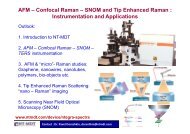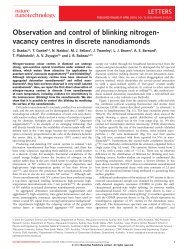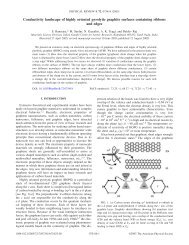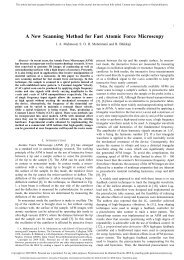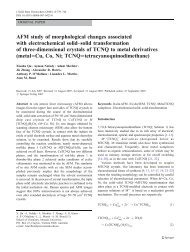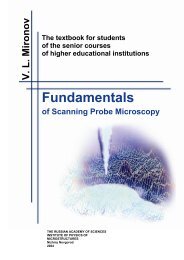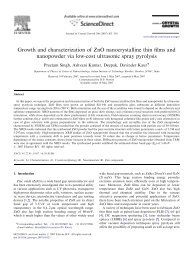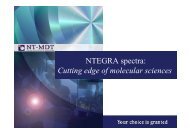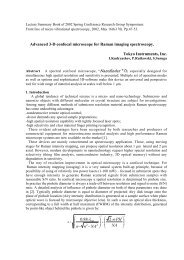Synthesis of biocompatible surfaces by nanotechnology methods
Synthesis of biocompatible surfaces by nanotechnology methods
Synthesis of biocompatible surfaces by nanotechnology methods
Create successful ePaper yourself
Turn your PDF publications into a flip-book with our unique Google optimized e-Paper software.
SYNTHESIS OF BIOCOMPATIBLE SURFACES BY NANOTECHNOLOGY METHODS 701nm12001000800600400200(a)0 200 400 600 800 1000 1200nmnm2.22.01.81.61.41.21.00.80.60.40.2012001000800600400200(b)0 200 400 600 800 1000 1200nm87654nm3210Fig. 6. AFM images <strong>of</strong> PMMA films: (a) initial film on silicon substrate; (b) nanostructured surface upon treatment in an oxygencontainingRF plasma.pressure <strong>of</strong> 2 and 100 Pa for various periods <strong>of</strong> time(0.5, 1, 2, 5, 10, and 20 min) on a setup described indetail elsewhere [3].The photon energy at λ = 123.6 is about 10 eV,which is large enough to excite polymer molecules andbreak chemical bonds such as C–C, C–H, C–CH 2 ,and C–O [15]. Photolysis leads to the formation <strong>of</strong>low-molecular-mass gaseous products such as CO,CO 2 , H 2 , H 2 O, and CH 4 , as well as to high-molecularmassgaseous products such as methyl formate(HCOOCH 3 ), formaldehyde (CH 2 =O), methanol(CH 3 –OH), and methyl methacrylate[CH 2 =C(CH 3 )–COOCH 3 ] [19]. In addition, exposureto VUV leads to the formation <strong>of</strong> intermolecularcross-links. Thus, the VUV-induced smoothing <strong>of</strong>PMMA nanorelief is due to the joint action <strong>of</strong> severalprocesses, including the photoetching <strong>of</strong> the polymer,the redeposition <strong>of</strong> the gaseous products <strong>of</strong> photolysis,and the formation <strong>of</strong> intermolecular cross-links. Thedegree <strong>of</strong> smoothing (at a fixed radiation intensity) isdetermined primarily <strong>by</strong> the treatment duration.An analysis <strong>of</strong> our results showed that even 2-minVUV irradiation produced clearly detectable smoothing<strong>of</strong> the roughnesses on the nanostructured PMMAsurface. After 10-min exposure, the average roughnesssize decreased <strong>by</strong> a factor <strong>of</strong> 2.6–3; the average lateralsize <strong>of</strong> nanograins was reduced <strong>by</strong> half, and their averageheight decreased <strong>by</strong> a factor <strong>of</strong> 15–18. Thus, 10-min VUV treatment rendered the PMMA film surfacepractically smooth.MODIFICATION OF PMMA SURFACEBY SYNCHROTRON RADIATIONIt was also <strong>of</strong> interest to study the modification <strong>of</strong>near-surface layers <strong>of</strong> polymers <strong>by</strong> irradiation in thehard VUV (λ = 50–100 nm) and s<strong>of</strong>t X-ray (λ = 10–50 nm) ranges. The experiments on polymer modificationin the short-wavelength spectral range wereperformed using a small synchrotron ring <strong>of</strong> the KurchatovSource <strong>of</strong> Synchrotron Radiation (Moscow).However, since it is still a difficult task to separate thecoherent collimated beams <strong>of</strong> various wavelengthsfrom the entire synchrotron spectrum, the samples <strong>of</strong>PMMA films were exposed to a beam <strong>of</strong> “white” synchrotronradiation (SR). The white beam representedSR in the entire spectrum with λ = 5–400 nm.The irradiation <strong>of</strong> PMMA <strong>by</strong> high-energy photons<strong>of</strong> the white SR beam leads to the formation <strong>of</strong> radicals(via the Norrish type I reaction) <strong>by</strong> rupturing chemicalbonds (C–C, C–H, C=O) with different energies andforming simple products such H 2 , CO, CO 2 , and CH 4 .At the same time, long-wavelength photons producethe reverse effect (cross linking). As a result, exposureto white SR is accompanied <strong>by</strong> the destruction <strong>of</strong>PMMA and the subsequent cross linking <strong>of</strong> the products.Figure 7 shows AFM images <strong>of</strong> the surface relief <strong>of</strong>PMMA films, which show evidence for self-organizationand a decrease in the size <strong>of</strong> nanostructured particles.An explanation <strong>of</strong> this phenomenon can bebased on the fact that polymers containing tertiarycarbon atoms and possessing low enthalpy <strong>of</strong> polymerizationare subject to depolymerization (thermodestruction).In addition, this is accompanied <strong>by</strong> UVradiation-inducedphotodestruction in the presence <strong>of</strong>C=O, which decreases the strength <strong>of</strong> bonds in thepolymer backbone. Both processes lead to polymerdestruction with a quantitative yield <strong>of</strong> monomers[15]. Thus the exposure <strong>of</strong> PMMA to the white SRbeam leads to the appearance <strong>of</strong> structured monomerson the sample surface.NANOTECHNOLOGIES IN RUSSIA Vol. 5 Nos. 9–10 2010


